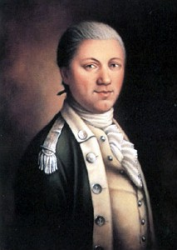
 |
|
|
||
|
Samuel Nicholas |
||||
|
Engagements: • Revolutionary War (1775 - 1783) |
||||
| Biography: | ||||
|
Samuel Nicholas Samuel Nicholas was born in 1744 in Philadelphia, PA, to Andrew and Mary Schute Nicholas. His father was a blacksmith and his uncle was Attwood Schute, the Mayor of Philadelphia (1756-58). Nicholas was educated at the College of Philadelphia (now the University of Pennsylvania). Military Service On 5 November 1775, Nicholas was commissioned a "Captain of Marines" by the Second Continental Congress, which was the first commission issued in the Continental Naval Service. His commission was confirmed in writing on November 28, eighteen days after the Continental Congress resolved on 10 November 1775, "That two battalions of Marines be raised consisting of one Colonel, two Lieutenant-Colonels, two Majors, and other officers, as usual in other regiments; that they consist of an equal number of Privates with other battalions; that particular care be taken that no persons be appointed to offices, or enlisted into said battalions, but such as are good seamen, or so acquainted with maritime affairs as to be able to serve by sea when required; that they be enlisted and commissioned to serve for and during the present war with Great Britain and the Colonies, unless dismissed by order of Congress; that they be distinguished by the names of the First and Second Battalion of Marines." As soon as Captain Nicholas received official confirmation of his appointment to office, he established a recruiting headquarters at Tun Tavern in Philadelphia. By January 1776, having recruited a sufficient number of Marines to man the vessels that comprised the Continental Navy in the waters of Philadelphia, Captain Nicholas assumed command of the Marine Detachment on board the USS Alfred. With Commodore Esek Hopkins in command, Alfred set sail from Philadelphia on the morning of 4 January 1776. The following month witnessed the baptismal fire of the Marines. Battle of Nassau Lord Dunmore, with the British force under his command, had collected a store of arms and provisions at New Providence, in the Bahamas, and had done a great deal of injury along the Colonial coast, particularly the shore of Virginia. Commodore Hopkins had been ordered to proceed to Abaco in the Bahamas, and from there to operate against the force of Lord Dunmore. Here the Commodore decided to make an attack on New Providence, capture the enemy's stores and cripple his supplies. Captain Nicholas was placed in command of the landing party, which consisted of about 250 Marines and sailors. This, the first successful landing engaged in by Continental Marines, led to the capture of Nassau on 3 March 1776 without a fight. On 6 April 1776, the Marines participated in the first naval battle between an American squadron and the British, when His Majesty's Ship HMS Glasgow came across the path of the squadron. Promoted to Major On 25 June 1776, Congress placed Nicholas "at the head of the Marines with the rank of Major." Accordingly, Commodore Hopkins was advised to send Major Nicholas to Philadelphia, with dispatches for the Continental Congress. With notification of his promotion he was ordered to report to the Marine Committee. The Committee detached him from Alfred and ordered him to remain in the city, "to discipline four companies of Marines and prepare them for service as Marine guards for the frigates on the stocks." Having recruited and thoroughly organized four companies, he requested arms and equipment for them. 1776-1779 In December 1776, he wrote Congress, "The enemy having overrun the Jerseys, and our army being greatly reduced, I was ordered to march with three of the companies to be under the command of His Excellency, the Commander-in-Chief." This was the first example of a battalion of Marines about to serve as an actual fighting unit under the direct command of Army authority. The Marines did not, however, engage in the attack on Trenton on 26 December 1776, which followed General George Washington's crossing of the Delaware River. They were attached to General John Cadwalader's division, which was ordered to cross the Delaware to Burlington, NJ, south of Trenton, in concert with Washington's crossing to the north on the night of 25 December 1776, but was turned back due to ice floes on the river. After the first Battle of Trenton, the battalion of Marines under the command of Major Nicholas participated in battle with a detachment of Cornwallis's main army at Princeton, NJ. During the ensuing months, Nicholas's battalion served both as infantry and artillery, participating in several skirmishes. Following the British evacuation of Philadelphia in June 1778, Marine Barracks were reestablished and recruiting resumed. From then until the close of the war, Nicholas's duties at Philadelphia were somewhat similar to those of later Commandants. Moreover, he was actively in charge of recruiting, and at times acted as Muster Master of the Navy. On 20 November 1779, he wrote Congress requesting that he be put in charge of the Marine Detachment aboard USS America, then in process of construction, but Congress was firm in its intention that Nicholas remain in Philadelphia. Honors Three ships in the U.S. Navy have been named USS Nicholas in his honor. On 10 November of each year, the date celebrated as the Marine Corps' birthday, Nicholas' grave in the Arch Street Friends Meeting graveyard in Philadelphia is marked with a wreath at dawn by a group of Marines. Return to Civilian Life After the disbandment of the Continental Marines and Navy following the end of the American Revolutionary War in 1783, Nicholas returned to civilian life. Death and Burial Major Samuel Nicholas died on 27 August 1790, in Philadelphia during an epidemic of yellow fever. He is buried at Friends Arch Street Meeting House Burial Ground in Philadelphia. |
||||
| Honoree ID: 2901 | Created by: MHOH | |||
Ribbons
Medals
Badges
Honoree Photos
 |  |  |
 |  |
 |


